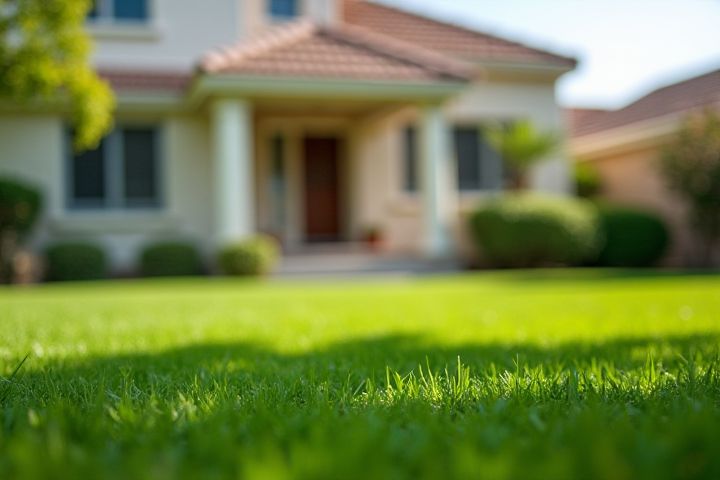
Begin by assessing your lawn's layout, identifying both sunny and shaded areas to select appropriate plants and grasses that thrive in each zone. Create a cohesive design by incorporating diverse elements such as flower beds, shrubs, ornamental grasses, and pathways that enhance visual interest and functionality. When choosing plants, consider factors like their growth height, blooming seasons, and maintenance needs to ensure year-round appeal. Installing an efficient irrigation system will help maintain healthy vegetation and conserve water, aligning with sustainable landscaping practices. Finally, adding features like decorative stones, mulch, and outdoor seating can create inviting spaces for relaxation and enjoyment in your transformed lawn.
How To Landscape A House Lawn
Soil preparation
Soil preparation is crucial for a lush lawn, beginning with a soil test to assess pH levels and nutrient content. Aim for a pH between 6.0 and 7.5 for optimal grass growth; you may need to amend your soil based on test results. Clear debris and weeds, then aerate the soil to a depth of 4 to 6 inches to improve drainage and root penetration. Finally, enrich the soil with organic compost or fertilizer, ensuring a nutrient-rich foundation for your new lawn.
Lawn design plan
To create an effective lawn design plan for your house, start by assessing your property's layout and sunlight exposure. Incorporate native plants and grasses that thrive in your climate, as they require less maintenance and promote biodiversity. Consider adding features such as pathways, borders, and decorative elements like sculptures or water features to enhance visual appeal. Finally, think about implementing sustainable practices, such as rainwater harvesting and mulching, to keep your lawn healthy while conserving resources.
Grass selection
Choosing the right type of grass is crucial for achieving a thriving lawn. Kentucky bluegrass, known for its rich green color and ability to thrive in cooler climates, requires 1 to 2 inches of water weekly. Bermuda grass, ideal for warmer regions, is drought-resistant and tolerates heavy foot traffic, needing about 1 inch of water weekly during growth periods. Consider your local climate, maintenance requirements, and desired lawn use when selecting grass to ensure a healthy and resilient landscape around your home.
Irrigation system setup
Setting up an effective irrigation system for your lawn is essential for maintaining a healthy landscape. Consider installing a combination of drip irrigation and sprinkler systems to ensure thorough coverage of all plant types while conserving water. Incorporate moisture sensors and timers into your irrigation design to automate watering schedules and prevent overwatering, optimizing water usage. Regularly check and maintain your irrigation components to ensure optimal performance and efficiency throughout the growing season.
Installation of edging
Installing edging in your lawn landscaping enhances both aesthetics and functionality. Select durable materials such as brick, stone, or plastic to create a clean barrier that separates your garden beds from the lawn. Begin by marking the desired edges with landscape spray paint or a garden hose to visualize the layout, then excavate a shallow trench where the edging will be placed. Ensuring the edges are level and secured, you'll improve water retention in planting areas while preventing grass encroachment, contributing to a polished, professional look for your landscape.
Fertilization strategy
A successful fertilization strategy for your lawn requires understanding the type of grass and its nutritional needs, which typically varies by region. For optimal growth, apply a balanced fertilizer with a ratio such as 10-10-10, ensuring 1 pound of nitrogen per 1,000 square feet every 6 to 8 weeks during the growing season. Soil testing is crucial; consider testing your soil pH and nutrient levels before applying, as ideal levels range from 6.0 to 7.0 for most grasses. To maximize effectiveness, water the lawn after application to activate the nutrients and promote deeper root growth.
Weed control methods
To effectively manage weeds in your lawn, consider implementing a multi-faceted approach that includes both preventative and reactive measures. Start by applying pre-emergent herbicides in early spring, targeting specific weeds before they take root; these products can reduce weed germination by up to 90%. Maintaining healthy turf through regular mowing, appropriate watering--aim for 1 inch per week--and nutrient management can outcompete weeds for resources. Incorporating techniques such as hand-pulling, overseeding, and mulching in garden beds can further enhance your weed control strategy, ensuring a healthy and vibrant lawn.
Mowing guidelines
Maintaining a well-manicured lawn requires adhering to specific mowing guidelines that promote health and aesthetics. Aim to mow when grass reaches about 3 to 4 inches in height, cutting no more than one-third of the grass blade at a time, which helps prevent stress and encourages deeper root growth. Sharpen your mower blades every 4 to 6 weeks to ensure clean cuts, as dull blades can damage the grass and invite disease. Mowing in different directions each time can also enhance the lawn's appearance and health by preventing compaction and promoting upright growth.
Pest management
Effective pest management is essential for maintaining a healthy lawn. Begin by identifying common pests in your area, such as grubs, chinch bugs, and aphids, which can significantly damage turf and plants. Implementing integrated pest management (IPM) strategies, such as introducing beneficial insects like ladybugs and maintaining healthy soil through proper fertilization and watering, enhances your lawn's resilience. Regular inspections of your lawn can help you catch pest issues early, ensuring that you only use targeted treatments when necessary, minimizing pesticide use and promoting a sustainable landscape.
Maintenance scheduling
Establish a maintenance schedule that incorporates mowing, watering, fertilizing, and aerating your lawn for optimal growth. Mowing should be conducted weekly during the growing season, ideally keeping grass at a height of 2.5 to 3.5 inches to promote healthy root systems. Watering is crucial; aim for one inch of water per week, adjusting based on rainfall and soil moisture. Fertilizing should occur every six to eight weeks with a balanced fertilizer to maintain soil health and encourage vigorous growth throughout the year.
